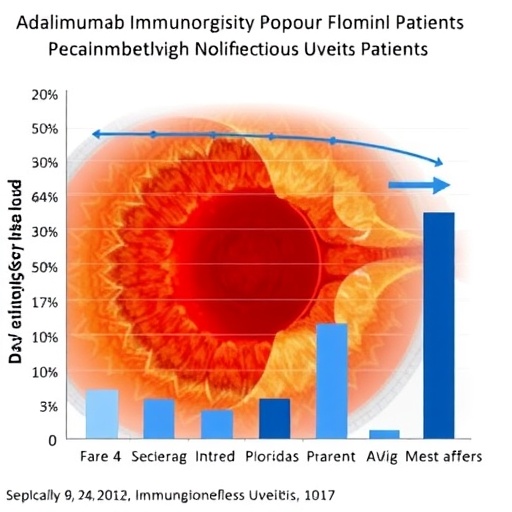A groundbreaking advancement in the realm of genome imaging has emerged with the introduction of CRISPR PRO-LiveFISH, an innovative approach that promises to revolutionize the study of three-dimensional chromatin dynamics and enhancer-promoter interactions within living cells. This method addresses longstanding limitations in visualizing dynamic genomic changes, particularly at non-repetitive loci, where traditional techniques have struggled due to the complexity and subtlety of chromatin architecture. The research, spearheaded by Liu and colleagues, unveils a sophisticated system that synergistically integrates orthogonal nucleic acid bases—derived from expanded genetic alphabets—with precisely engineered single guide RNAs (sgRNAs), enabling unprecedented multiplexed imaging capability.
The core innovation of CRISPR PRO-LiveFISH lies in its ability to label multiple specific genomic sites simultaneously without relying on repetitive sequences or amplifying the fluorescent signal, a hurdle that has traditionally hindered the real-time study of chromatin. By harnessing orthogonal bases—unnatural nucleotide components that extend beyond the conventional A, T, C, and G—the researchers have enhanced the specificity and stability of sgRNA-DNA interactions. This molecular expansion bolsters the efficiency of CRISPR-based labeling, dramatically reducing the number of sgRNAs required to achieve bright, distinguishable signals at discrete non-repetitive loci. Remarkably, the method achieves robust visualization with as few as ten sgRNAs per locus.
One of the most compelling features of CRISPR PRO-LiveFISH is its multiplexing capacity, enabling simultaneous imaging of up to six distinct genomic loci within living cells. This capability signifies a quantum leap from previous CRISPR imaging techniques, which typically focused on repetitive regions and were limited in multiplexing due to signal overlap and noise. The expanded genetic alphabet technology not only enhances signal clarity but also provides the orthogonality necessary to prevent cross-talk among labeled sites. Consequently, researchers can now obtain dynamic, high-resolution insights into the spatial organization and temporal interactions of genomic elements within their native cellular context.
The utility of CRISPR PRO-LiveFISH extends across various cell types, including primary cells, which are notoriously difficult to manipulate genetically. This adaptability underscores its promise for translational and biomedical applications, particularly where preserving native cell behavior is paramount. The research team demonstrated the method’s robustness across diverse cellular environments, showcasing its potential as a versatile tool to decode the complexities of chromatin architecture and gene regulation in live cells.
By applying CRISPR PRO-LiveFISH to enhancer-promoter dynamics, the study delves into the mechanisms underpinning gene expression regulation at multiple scales. Enhancers are distal regulatory elements that modulate promoter activity and thus fine-tune gene transcription, yet their interactions are often transient and spatially complex. This novel imaging platform captures these fleeting enhancer-promoter contacts in real time, revealing intricate dynamics that were previously inaccessible with static or population-averaged approaches.
A particularly striking finding from the research involves the PCDHα gene cluster, where enhancer-promoter interactions appeared to persist despite significant spatial mobility within the nucleus. This observation challenges conventional models that posit stable genomic contacts as a precondition for consistent gene regulation. Instead, it suggests a model where dynamic motion and flexible chromatin looping coexist with sustained regulatory interactions, illuminating new dimensions of genome organization.
Equally impactful is the exploration of super-enhancer dynamics in cancer cells, focusing on the MYC oncogene, a critical driver of tumorigenesis. The study highlights the role of BRD4, a bromodomain-containing protein that stabilizes super-enhancer contacts. Using CRISPR PRO-LiveFISH, the researchers visualized how BRD4 maintains spatial proximity between super-enhancers and the MYC promoter, a relationship integral to oncogenic transcriptional programs. These insights could have profound implications for targeted therapies disrupting enhancer-promoter crosstalk in cancer.
Technical sophistication marks this advancement, where the researchers optimized sgRNA design by rational engineering, integrating orthogonal base pairs strategically to maximize binding specificity and minimize off-target effects. The method’s design transcends simple guide RNA targeting by embedding a supplementary informational layer through expanded bases, thereby increasing hybridization precision and signal fidelity. This strategic molecular design represents a paradigm shift in CRISPR-based live-cell imaging.
Moreover, the technique’s requirement for only small numbers of sgRNAs per locus reduces the molecular burden on cells, minimizing potential perturbations to native genomic processes. This fine balance between labeling efficiency and cellular integrity is crucial for accurate representation of chromatin dynamics, as invasive or excessive labeling can artifactually influence genome structure and function.
The high temporal resolution achieved by CRISPR PRO-LiveFISH enables real-time tracking of three-dimensional genome reorganization over extended periods, an essential feature to study dynamic cellular processes such as differentiation, cell cycle progression, and response to stimuli. By capturing chromatin motion in live cells, researchers can now link physical genome rearrangements to functional outcomes like epigenetic modification patterns and transcriptional flux.
Importantly, the correlation observed between genomic dynamics and specific epigenetic states opens avenues to dissect how chromatin modifications regulate spatial genome architecture. Epigenetic marks serve as critical modulators of chromatin accessibility and compaction, thereby influencing gene expression landscapes. This method facilitates simultaneous visualization of spatial positioning and epigenetic status, potentially unraveling complex regulatory networks that determine cell fate and identity.
The implications of CRISPR PRO-LiveFISH extend beyond fundamental biology into disease research, developmental biology, and synthetic biology. Understanding chromatin dynamics and enhancer interactions at high resolution can elucidate the mechanisms behind genetic disorders rooted in misregulated enhancer activity and chromosomal rearrangements. Furthermore, this technology can aid precision editing strategies by mapping target loci movements and accessibility in living cells.
In terms of broader impact, CRISPR PRO-LiveFISH bridges a critical technological gap by offering a non-invasive, multiplexed, and highly specific imaging platform compatible with live-cell applications. This stands to accelerate discoveries in genome biology, facilitating studies that were hitherto limited to fixed-cell analyses or bulk population approaches, thus rarely capturing the nuance of individual cellular heterogeneity.
The research team’s methodology combines the growing field of synthetic biology—through expanded genetic alphabets—with cutting-edge CRISPR-Cas systems, exemplifying how interdisciplinary innovation can produce tools with exponential gains in capability. It underscores an emerging trend of enhancing biological research toolkits by integrating chemically expanded genetic codes, a frontier with vast potential beyond imaging.
Finally, the publication of this work in Nature Biotechnology signifies its peer-validated scientific rigor and importance. As more laboratories adopt CRISPR PRO-LiveFISH, the depth of our understanding regarding genome dynamics, spatial gene regulation, and chromatin-interacting factors is expected to grow exponentially. This advancement not only redefines the limits of live-cell genomic imaging but opens paths to therapies targeting genome architecture and its dysregulation in disease.
Subject of Research:
Chromatin dynamics, enhancer-promoter interactions, and genome organization within living cells analyzed using CRISPR-based live-cell imaging.
Article Title:
CRISPR live-cell imaging reveals chromatin dynamics and enhancer interactions at multiple non-repetitive loci.
Article References:
Liu, M., Huang, K., Zhang, J. et al. CRISPR live-cell imaging reveals chromatin dynamics and enhancer interactions at multiple non-repetitive loci. Nat Biotechnol (2025). https://doi.org/10.1038/s41587-025-02887-3
Image Credits:
AI Generated
DOI:
https://doi.org/10.1038/s41587-025-02887-3
Tags: chromatin dynamics visualizationCRISPR live imaging technologyCRISPR-based labeling efficiencyenhancer-promoter interactionsexpanded genetic alphabetsgenome imaging advancementsmolecular imaging in living cellsmultiplexed imaging capabilitiesnon-repetitive genomic lociorthogonal nucleic acid basesreal-time chromatin studysingle guide RNA engineering





